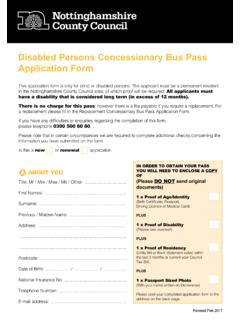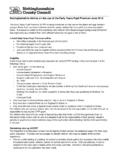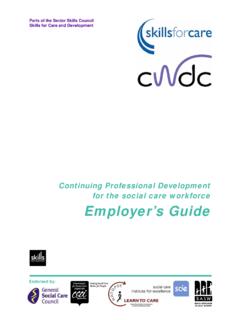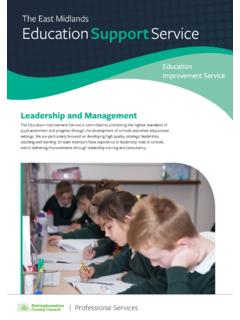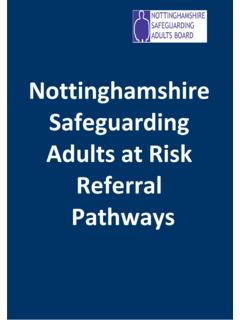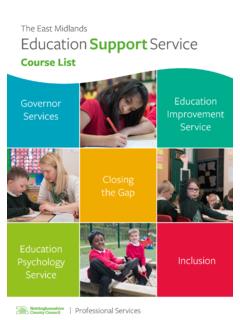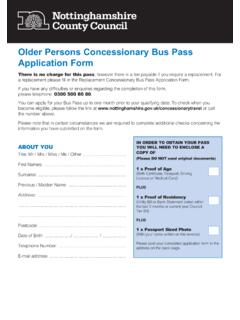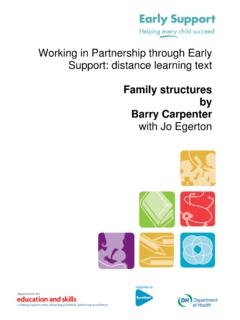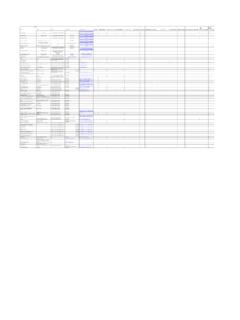Transcription of Pathway to Provision - nottinghamshire.gov.uk
1 Pathway to ProvisionMulti-Agency Thresholds Guidance for Nottinghamshire Children s ServicesVersion 7 (February 2018) Pathway to Provision Contents IntroductionIn September 2010, the first version of the Pathway to Provision Handbook was launched. The purpose of the Pathway to Provision handbook is to support practitioners to identify an individual child s, young person s and/or family s level of need and to enable the most appropriate referrals to access Provision . It is especially critical that appropriate referrals are made to Children s Social Care to ensure the safety of children and young people in document mainly applies to young people who are resident in Nottinghamshire ( their home address is in the County) but there may be some exceptions to this (for example chldren who are on roll at a county school but are persistently absent).
2 If you are in doubt please contact the Early Help Unit or MASH for A The Nottinghamshire Continuum of Children and Young People s Needs.. 1 A1 The Assessment Framework .. 1 A2 Levels of Need.. 1 Section B Multi-Agency Thresholds Guidance .. 3 Level 1 Threshold Universal .. 4 Level 2 Threshold Early Help.. 6 Level 3 Threshold Targeted Early Help .. 8 Level 4 Threshold Child in need of Specialist Services..11 Thresholds for Children s Social Care Involvement ..12 Section C C1 Outline of the Pathway to Provision ..15 C2 The Early Help Pathway ..16 C3 The Safeguarding (Children s Social Care) Pathway ..17 C4 Children & Young People with Disabilities Pathway ..18 Section D D1 Step Down Practice Guidance ..20 D2 Nottinghamshire s Multi-Agency Concerning Behaviours Pathway ..21 D3 Health Family Teams..22 D4 Child and Adolescent Mental Health Services.
3 23 D5 Concerns about extremist views and behaviour..25 D6 Concerns about children displaying sexually harmful behaviour..25D7 Crime Prevention Referral Criteria ..25D8: Neighbouring Authorities Access Points ..271 Pathway to Provision Section ASection A: The Nottinghamshire Continuum of Children and Young People s NeedsA1 The Assessment FrameworkAssessing the needs of a child or young person and their family requires a systematic andpurposeful approach. The assessment framework gives agencies working with children and youngpeople a common language to understand both the needs of the child/young person and what ishappening to them. Using the assessment framework provides a way to gather and analyserelevant information within three domains: the developmental needs of the child the parental capacity (or caregiver capacity) to meet the child s needs the impact of the wider family and environmental factors on both parenting capacity and the child s information on carrying out assessments can be found at Levels of NeedThe model used to illustrate the different levels of children and young people s needs inNottinghamshire is referred to as the Nottinghamshire Continuum of Children and Young People sNeeds (see figure 1) which recognises that children, young people and their families will havedifferent levels of needs, and that a family s needs may change over time.
4 The agreed multiagencythresholds are set out across four levels of need which are: Universal (Level 1) Children and young people who are achieving expected outcomes and havetheir needs met within universal service Provision without any additional supportEarly Help (Level 2) Children and young people where some concerns are emerging and whowill require additional support usually from professionals already involved with themTargeted Early Help (Level 3) Children and young people who are causing significant concernover an extended period or where concerns recur frequentlySpecialist (Level 4) Children and young people who are very vulnerable and where interventionsfrom Children s Social Care are requiredIt is important to recognise that children and young people will move between the different levels,as their needs change, for example from Level 4 to Level 3 or from Level 2 to Level 1.
5 The modelprovides a framework to develop a common understanding amongst practitioners of children andyoung people s needs and their vulnerabilities, shared assessment procedures and a platform forinter-agency and multi-agency working through the early help offer which includes earlyintervention and prevention and targeted support for young A Pathway to ProvisionThe Nottinghamshire Continuum of Need model is consistent with the NottinghamshireSafeguarding Children Board (NSCB) Procedures and the national guidance WorkingTogether (2015). The model is underpinned by the following principles: it is child-centred it is holistic in approach it is focused on outcomes for children and young model recognises that children and young people s welfare and safety is everyone sresponsibility and that we all have a duty, as stated in the Children Act 2004, to promotecooperation between the County Council and its partners with a view to improving the well-being ofchildren and young people.
6 All partners have a duty under section 11 of the Children Act 2004, tosafeguard and promote the welfare of children and young people and that all services support general, children and young people with disabilities will have their needs met through Early Help, targeted Early Help Services and the Integrated Children s Disability The Nottinghamshire Continuum illustrates the levels of need rather than numbers of children at each 1: The Nottinghamshire Continuum of Children and Young People s NeedsEHAF and Team Around the Family MeetingsLevel 1 Children in need ofUniversal ServicesLevel 2 Children in need ofEarly Help ServicesLevel 3 Children in need of Targeted Early Help Services Level 4 Children in need ofSpecialist Services3 Pathway to Provision Section BSection B: Multi-Agency Thresholds GuidanceThis section provides definitions and indicators for practitioners to assist in the identification oflevels of need for children and young people.
7 It also includes guidance on when to commence theEarly Help Assessment process and/or make a referral to the appropriate service withinNottinghamshire s Pathway to multi-agency threshold guidance provides definitions and indicators for practitioners to assistin the identification of levels of need for children and young people (from conception to 18 years, or25 years if the young person has a learning difficulty or disability). A threshold in this guidance isthe point at which we weigh up what is happening and what action is needed in order to meet achild s needs. This involves professional and personal values. This document is not intended to bea definitive list but provides a framework to identify when a child or young person may be at risk ofpoor outcomes, alongside guidance on when to commence the Early Help Assessment process ormake a referral to early help services.
8 There is no substitute for sound professional judgement,effective inter and intra-agency communication and good evidence based practice based on up todate document should be read alongside the Nottinghamshire Safeguarding Children s Board(NSCB) procedures that reflect the legal framework underpinning work with children to promotetheir welfare and prevent abuse. These procedures are available at: there are legal duties to provide statutory services. Where this is not the case, there isno guarantee of service Provision by particular agencies at each level as there may be restrictingfactors such as age limits, specific service criteria and a history of previous interventions. It isacknowledged that children and young people may move from one level of need to another ineither direction and that agencies (including universal services) may offer support at more than use of this framework by local agencies and programmes enables them to work bettertogether, share information more easily and facilitates referrals between organisations.
9 It benefitschildren, young people and families by enabling them to understand what information agencies areseeking and why, and helps them to judge whether they are getting the services they IndicatorsThe following pages provide definitions and indicators grouped around the three domainsof the assessment triangle to assist practitioners in identifying levels of need. It isimportant to recognise that children and young people will move between the differentlevels as their needs B Pathway to ProvisionLevel 1 Threshold: Universal Services Children or young people who don t present significant concerns and are living in circumstances where there may be worries, concerns or conflicts over time but these are infrequent, short lived and quickly resolved by the family themselves or with support and guidance from extended family, the community or professionals with whom they are normally in touch.
10 Universal services have an essential role in creating the circumstances in which safe and happy children and families can flourish. Universal services, working with communities, are also those most likely to identify that a problems is emerging with a child or in a s Developmental NeedsParents and CarersHEALTH Good physical health Adequate diet/hygiene/clothing Developmental checks/immunisations up to date Accesses health services Developmental milestones met including Speech & Language Appropriate height & weight Healthy lifestyle Sexual activity appropriate for age Good state of mental health No substance misuse (including alcohol)EDUCATION & LEARNING Good attendance at school/college/training No barriers to learning Achieving key stagesEMOTIONAL & BEHAVIOURAL DEVELOPMENT Growing level of competencies in practical and emotional skills Good quality early attachmentsIDENTITY Positive sense of self & abilities Demonstrates feelings of belonging & acceptance An ability to express needsFAMILY & SOCIAL RELATIONSHIPS Stable & affectionate relationships with care givers Good relationships with siblings Positive relationships with peersSOCIAL PRESENTATION Appropriate dress for different settings Good level of personal hygieneSELF-CARE SKILLS Age appropriate independent living skillsBASIC CARE.

